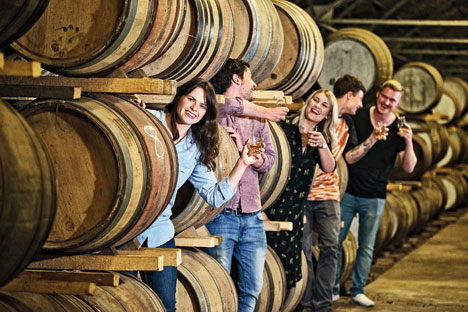
Each of my visits to Scotland has been short but memorable, whether it’s stumbling along a bumpy cobblestone street after a party in Edinburgh or trekking through the scenic forests north of Helensburgh. The only thing that can be distracting is the harsh weather but if you’re prepared — coat, hat, boots and gloves — Scotland is stunning in its simplicity and rustic charm and the Scots are alarmingly friendly and gracious.
If, like me, you are not a whisky connoisseur, you will be well on your way to becoming one after three days in Scotland. Apart from the fact that they produce the best single malts in the world (so there is much to learn and discover), the cold weather and the company encourage you to imbibe the brew... in quantities you would not imagine!
I start my journey in Glasgow and travel by car to Girvan to learn about Hendrick’s Gin and a new malt (for me anyway) called Ailsa Bay. The gin distillery is small with only two large copper stills. It is difficult to believe that they supply the entire world from here. Gin seems to be a simple process of a first distillation of pure spirit and a second distillation with the all important aromatics; juniper, of course, Bulgarian rose, coriander seed, elderflower, camomile and a whole bunch of strange things, like the feathery white yarrow flower you see in British meadows, and orris root from the Iris flower. Hendrick’s uses a blend of spirits produced from a Carter-Head still (constructed in 1948; it bathes the botanicals in vapour to extract their flavour compounds and oils), of which there are only a small number in the world, and a small pot still (an apparatus used to distil liquid mixtures), originally built in 1860.

Next door are the Grant warehouses which also store for other whisky companies in west Scotland, including their new malt Ailsa Bay named after a piece of volcanic rock and its bay a mile down the road. This malt is different in that it is smoky and heavily peated (some Scotch whisky distilleries use peat fires to dry malted barley) which is unusual for a Lowlands malt whisky. I was reliably informed that the peat profile of single malt is obtained from dead heather roots, which is indeed difficult to replicate. Ailsa Bay is aged in old Bourbon barrels and some new American oak, so it has a lighter appearance and a bit of a spice note.
The Americans, I learn, can only use their barrels once. The Scots are happy to have their old ones, which work well for their single malts. I especially like the honeyed-flavour finish of Ailsa Bay. It is clearly aimed at a new, young single malt drinking market which wants the characteristics associated with a single malt without the complexity of ageing. The new age medicinal bottle reminiscent of Japanese malts is, I guess, no accident.
Into Speyside
A quick lunch at Souter’s Inn where I wallop a fabulous creamy fish gratin full of Scottish smoked haddock, salmon and local plump prawns… a flight and a drive later to the north-east of Scotland to Dufftown.

Dufftown, despite being the home of the famous William Grant (founder of William Grant & Sons, which owns the distilleries of Glenfiddich, Balvenie, Girvan, Kininvie, Ailsa Bay and Tullamore), one of the biggest names in single malt whiskies in the world, is still a tiny Speyside village of 1,500 people, almost all of whom work in the whisky industry. The Glenfiddich distillery and tour by a team of highly knowledgeable people in kilts is a wonderful initiation into whisky making and malts in general. You learn the process of how barley is malted and the different casks used for ageing and by the end of a couple of tours and tastings, I actually feel I have begun to understand the difference casks make to the final taste of the whiskies.
There are 60 distilleries in Speyside but the William Grant & Sons portfolio of Grant’s, Glenfiddich and Balvenie will give you an idea of what a successful family business is all about. Incidentally, they also produce a whisky which the men in my family have been pouring for a while now, Monkey Shoulder. Named after the stooped shoulders the poor men get after turning the barley by hand with a pitchfork (this is rarely done by hand anymore except for a notional amount to keep the tradition alive at Balvenie). This is a whisky to look out for. It is a pure malted whisky (but not a single malt) made from Glenfiddich, Balvenie and Kininvie and far superior to most of the “Scotch” on the market.

Glenfiddich 12 Years is exported to 184 countries, while the 12 Years is more fruity and floral in style, the 18-year-old big brother has a more baked apple, caramel, spice profile. The Glenfiddich 26 Years, if you can get hold of it, is another story. Matured in 100 per cent first filled bourbon barrels, it is light-coloured and very refined. Today whisky is made from wheat and malted barley. This is a relatively new phenomenon. Pre-1980, maize was used.
The Balvenie tour and tasting is a much more intimate experience especially if you have their ambassador David Mair conducting it. He is passionate beyond belief and seems to know everything about whisky. Plus he doesn’t make me feel like a complete idiot when I ask him what I am sure are silly questions. The tasting after the tour is a marvel of taste and education. You taste five-six different whiskies from Tun 1509 made from 23 different cask blends to a 50-year-old to the Caribbean cask finished in rum barrels, Port wood which resonates raisins and prunes and a dark DoubleWood finished in American oak and sherry casks.
...And a detour
While you are in this neck of the woods and if you want some respite from the “whisky” experience, please visit Gordon Castle — a worthwhile little detour in the middle of the Scottish countryside. If you’re lucky enough you may bump into the owner Angus Gordon Lennox (descendant of the Duke of Richmond and Gordon) who along with his wife Zara have restored and revived his ancestral home and impressive grounds into something dreams are made of. The estate hosts many sporting activities and is a fine example of 21st century sustainability. You can stay in any of the luxurious bedrooms overlooking the garden, fish with experts, visit their organic garden, their restaurant and cafe and enchanting gift shop. Stately homes, castles and manor houses dot the British countryside… Gordon castle is very special much like its affable owner.

One more must-do in the area is Johnstons of Elgin. When I mentioned I was near Elgin to friends in the UK, they all jumped and insisted I visit Johnston’s, apparently the last word in cashmere. This is another family business worth talking about. Run by Jenny Houldsworth, Johnston’s occupies an entire corner of the village with a dedicated parking, two floors of the most exquisite cashmere ware, suits and jackets, a large gift shop, cafe (with great cakes) and a cashmere museum. The difference between cashmere and pashmina is that the former is knitted by machine so you have cashmere cardigans and sweaters. Indian pashmina is supposed to be woven by hand or spun. Although my feeling is that there is a lot of nonsense and abuse surrounding the word “pashmina”. They also have a factory nearby employing over 100 people from the village. It was heartening to shop here and know that some things are still made in Britain and not China!
If you are visiting the UK this summer, I strongly suggest a trip to Scotland. The whisky trail is of course a must and William Grant & Sons is a fabulous three-day experience…but leave time for the castles and shops too!

DAVID MAIR OF BALVENIE DISCUSSES MALTS WITH KAREN ANAND
What do the terms peaty, smoky, fruity mean in terms of malts?
Peaty/Smoky: Barley seeds during the essential malting process can be peat-smoked. In the final stage of malting — the drying process of the germinated barley seeds — the more peat which is burned at this stage, the more smoke gets produced and absorbed into the grain, resulting in a higher level of “smokiness” in the mature whisky. Scottish peat is produced from dead heather roots and so the peat gives off a unique smell.
Fruity: The characters in malt whiskies are variable and describing nose and taste is totally subjective. However, fruitiness is regularly detected in malt whiskies and described often in comparison to various common fruits, honey, fruit cake and so on.
How does ageing help a malt?
Ageing helps a malt whisky but first... the law of maturing our whisky means it must be matured for a legal minimum period of three years in oak casks, in Scotland. Oak was chosen in early 1900s as the wood allowed for some evaporation to take place, absorption into the wood, and uptake of colour and flavour. The longer the liquid is in the cask, the deeper/richer/ more complex its flavour, and increasingly more colour will be imparted. Oak itself, therefore, has excellent flavour-giving characteristics and varies depending on how new the wood is, and to a lesser extent, what might have been in the cask previously (American whisky, sherry, port, rum, wine, and so on).
Why Balvenie/Grant being a family-run company is so different from other malt whisky companies? What impact does this have on the product?
Being family-owned and run I feel is very beneficial. The vision for Balvenie is to remain traditional, retaining our handcrafted elements of production — growing and malting our own barley, having coopers (someone in the trade of making utensils and barrels) to tend our casks, a coppersmith to take care of our stills, and a malt master (currently David C. Stewart, MBE) to maintain our Balvenie malt whisky character and range.
What is the general difference between malts from Highland/ Speyside and the Lowlands?
Speyside malts tend to be soft, sweet and mellow. Lowland malts are somewhat light and delicate, and Highland malts often veer towards sweet/smoky/salty.

Karen Anand is a culinary consultant, food writer and entrepreneur. In recent times her name has been synonymous with farmers’ markets. Follow her on www.facebook.com/karenanand










